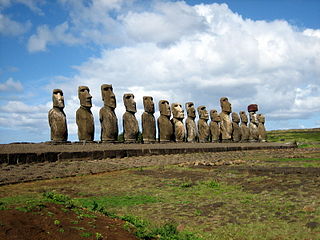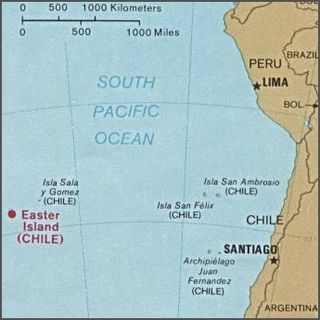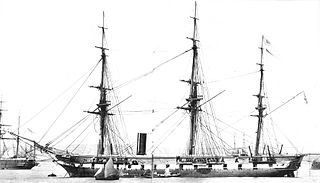Related Research Articles

Moai or moʻai are monolithic human figures carved by the Rapa Nui people on Rapa Nui in eastern Polynesia between the years 1250 and 1500. Nearly half are still at Rano Raraku, the main moai quarry, but hundreds were transported from there and set on stone platforms called ahu around the island's perimeter. Almost all moai have overly large heads, which account for three-eighths of the size of the whole statue. They also have no legs. The moai are chiefly the living faces of deified ancestors.

Rano Raraku is a volcanic crater formed of consolidated volcanic ash, or tuff, and located on the lower slopes of Terevaka in the Rapa Nui National Park on Easter Island in Chile. It was a quarry for about 500 years until the early eighteenth century, and supplied the stone from which about 95% of the island's known monolithic sculptures (moai) were carved. Rano Raraku is a visual record of moai design vocabulary and technological innovation, where 887 moai remain. Rano Raraku is in the World Heritage Site of Rapa Nui National Park and gives its name to one of the seven sections of the park.

Katherine Maria Routledge was an English archaeologist and anthropologist who, in 1914, initiated and carried out much of the first true survey of Easter Island.

Aku-Aku: the Secret of Easter Island is a 1957 book by Thor Heyerdahl published in Norwegian, Swedish, Danish and Finnish, and in French and English the following year. The book describes the 1955–1956 Norwegian Archaeological Expedition's investigations of Polynesian history and culture at Easter Island, the Austral Islands of Rapa Iti and Raivavae, and the Marquesas Islands of Nuku Hiva and Hiva Oa. Visits to Pitcairn Island, Mangareva and Tahiti are described as well.

Makemake in the Rapa Nui mythology of Easter Island is the creator of humanity, the god of fertility and the chief god of the "Tangata manu" or bird-man sect. He appeared to be the local form, or name, of the old Polynesian god Tane. He had no wife.

Hoa Hakananai'a is a moai, a statue from Easter Island. It was taken from Orongo, Easter Island in 1868 by the crew of a British ship and is now in the British Museum in London.

Orongo is a stone village and ceremonial center at the southwestern tip of Rapa Nui. It consists of a collection of low, sod-covered, windowless, round-walled buildings with even lower doors positioned on the high south-westerly tip of the large volcanic caldera called Rano Kau. Below Orongo on one side a 300-meter barren cliff face drops down to the ocean; on the other, a more gentle but still very steep grassy slope leads down to a freshwater marsh inside the high caldera.

Poike is one of the three main extinct volcanoes that form Rapa Nui, a Chilean island in the Pacific Ocean. At 370 metres above sea level, Poike's peak is the island's second-highest point after the peak of the extinct volcano Terevaka.

Rano Kau is a 324 m (1,063 ft) tall extinct volcano that forms the southwestern headland of Easter Island, a Chilean island in the Pacific Ocean. It was formed of basaltic lava flows in the Pleistocene with its youngest rocks dated at between 150,000 and 210,000 years ago.
Since the removal from Easter Island in 1868 of the moai now displayed at the British Museum, a total of 12 moai are known to have been removed from Easter Island and to remain overseas. Some of the moai have been further transferred between museums and private collections, for reasons such as the moai's preservation, academic research and for public education.

Geologically one of the youngest inhabited territories on Earth, Easter Island, located in the mid-Pacific Ocean, was, for most of its history, one of the most isolated. Its inhabitants, the Rapa Nui, have endured famines, epidemics of disease, civil war, environmental collapse, slave raids, various colonial contacts, and have seen their population crash on more than one occasion. The ensuing cultural legacy has brought the island notoriety out of proportion to the number of its inhabitants.

HMS Topaze was a 51-gun Liffey-class wooden screw frigate of the Royal Navy. She was launched on 12 May 1858, at Devonport Dockyard, Plymouth.

The Father Sebastian Englert Anthropological Museum is a museum in the town of Hanga Roa on Rapa Nui in Chilean Polynesia. Named for the Bavarian missionary, Fr. Sebastian Englert, OFM Cap., the museum was founded in 1973 and is dedicated to the conservation of the Rapa Nui cultural patrimony.

William Scoresby Routledge, FRGS (1859–1939) was a British ethnographer, anthropologist and adventurer. With his wife, Katherine Routledge, he completed the first ethnographies of the Kikuyu and the people of Rapa Nui.

Hotu-iti is an area of southeastern Easter Island that takes its name from a local clan. Located in Rapa Nui National Park, the area includes Rano Raraku crater, the Ahu Tongariki site, and a small bay. In the 15th and 16th centuries, the Hotu-iti clan was one of two polities on Easter Island.

The Mana Expedition to Easter Island occurred between March 1913 and August 1915. It was the first archaeological expedition to Easter Island which was privately organized and funded, preceding the Norwegian Archaeological Expedition to Easter Island of Thor Heyerdahl by more than 40 years. The Mana Expedition was led by Katherine and William Scoresby Routledge. The expedition and its ship, the Mana, bore the same name. The ship left Falmouth, England on 13 March 1913 with a crew of twelve, including a surveyor, geologist, sailing master, navigator, engineer, cook, seamen, a cabin boy and the Routledges. They arrived on the southern coast of the island at Hanga Roa Bay, by way of the Strait of Magellan, on 29 March 1914, setting up their first camp at Mataveri, on the island's southwest corner. The English archaeologist O. G. S. Crawford referred to the expedition as "an archaeological fiasco".

Angata, full name María Angata Veri Tahi ʻa Pengo Hare Koho was a Roman Catholic Rapa Nui religious leader from Easter Island during the late 19th and early 20th century. After experiencing a prophetic vision in which God instructed her to retake the land and livestock, she led an unsuccessful rebellion on the island against the Williamson-Balfour Company, intending to create a theocracy centered on Roman Catholicism and Rapa Nui spiritual values.

Juan Tepano Rano ʻa Veri ʻAmo was a Rapa Nui leader of Easter Island. He served as an informant for Euro-American scholars on the culture and history of the island.
Enrique Ika a Tuʻu Hati was elected ‘ariki (king) of Rapa Nui in 1900 and led a failed rebellion. He was one of the last Rapa Nui to claim the traditional kingship in the early 20th-century. However, he is not remembered as the last king; instead his predecessor Riro Kāinga is generally regarded as the last king, although neither held much power.

Victoria Veriamo a Huki a Parapara, also known as Viriamo was one of the last surviving indigenous women of Easter Island to have been tattooed using traditional practices, along with Ana Eva Hei. She was a cultural informant who shared her knowledge of indigenous Rapa Nui culture with European visitors, as well as with her son Juan Tepano, who in turn also functioned as a cultural informant.
References
- ↑ "UCLA Rock Art Archive". Sscnet.ucla.edu. Archived from the original on December 20, 2002. Retrieved 2013-08-31.
- ↑ "EISP". Sscnet.ucla.edu. Archived from the original on August 3, 2003. Retrieved 2013-08-31.
- ↑ "Awards on Easter Island". Los Angeles Times. 16 March 1995. Retrieved June 2, 2018.
- ↑ Van Tilburg, Jo Anne (2003). Among Stone Giants: The Life of Katherine Routledge and Her Remarkable Expedition to Easter Island . New York: Scribner. ISBN 0-7432-4480-X.
- ↑ "NOVA Online | Secrets of Easter Island". Pbs.org. Retrieved 2013-08-31.